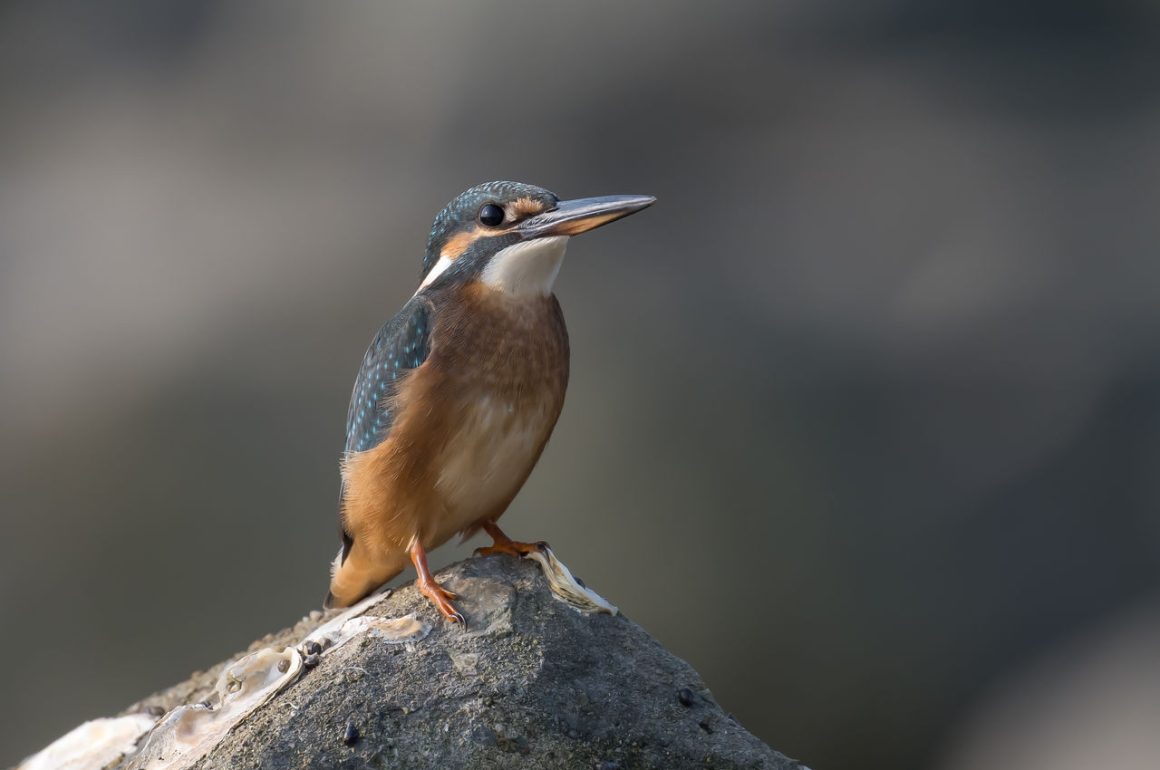
For some collaborative posts, it seems to be difficult to find writers. For one on kingfishers, it is not. Unsurprising, given how spectacular many of them look.
Pied Kingfisher
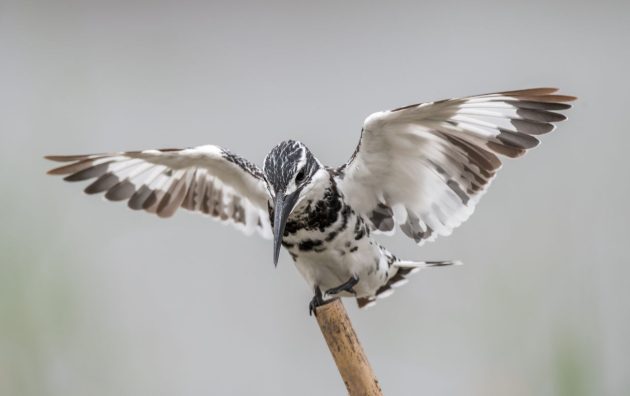
I love colour in birds and kingfishers are a colourful lot. But, I find the Pied Kingfisher very natty in its black and white plumage. Unlike most kingfishers, which are solitary except in the breeding season, the Pied lives in family units and roosts together. I saw an example of that in 2006 when I saw my lifer Pied Kingfisher in Israel. We were visiting the Hulah wetlands. A Pied was hunting over the water. While it was hovering, another Pied flew up and poked it. The first bird shook it off and kept hovering. The second bird didn’t give up and moved in again. It was like watching a bratty sibling pester a busy sibling. Finally, the hunting bird chased after the other one, which was the whole point of the game. That entertaining interlude is why the Pied Kingfisher is my favorite member of the kingfisher family (Leslie Kinrys).
Stork-billed Kingfisher
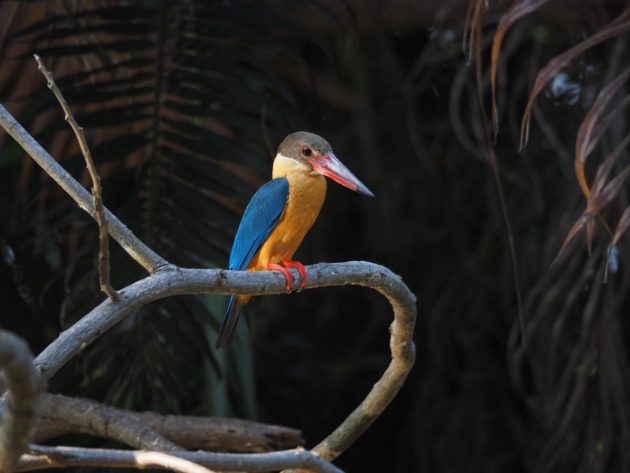
There are a dozen species of kingfishers to be found on the sub-continent of India: the Stork-billed isn’t the largest (the Crested beats it by a mere 3cm), but it is arguably the most spectacular. It’s not called Stork-billed for nothing, for it has a huge coral-red beak. So, too, does the Brown-winged Kingfisher, but the latter is restricted to a tiny area of east India and Bangladesh, while the Stork-billed Kingfisher ranges all the way from the foothills of the Himalayas to Sri Lanka.
Locally common, this bird favors deep-shaded lakes and slow-moving rivers and streams. Its liking for shady spots makes it a bird that’s tricky to see, as it will fish patiently for hours in the same spot, so you are more likely to hear it than see it. Its call is as loud and unsubtle as the bird itself, A Guide to the Birds of India describes it as an “explosive, shrieking laugh”, which sums it up nicely. My photograph was taken at Ranganathittu Bird Sanctuary, a bird-filled 40-acre reserve a short drive from the city of Mysore, in the southern Indian state of Karnataka. The sanctuary is a popular destination so generally crowded with visitors, but that means that the birds are used to people, making them unusually tame and approachable. I noted in my diary that I didn’t see any other visitors with binoculars, but the sanctuary was well-kept and litter-free, while the kingfisher took absolutely no notice of the crowds walking past (David Tomlinson).
Common Kingfisher
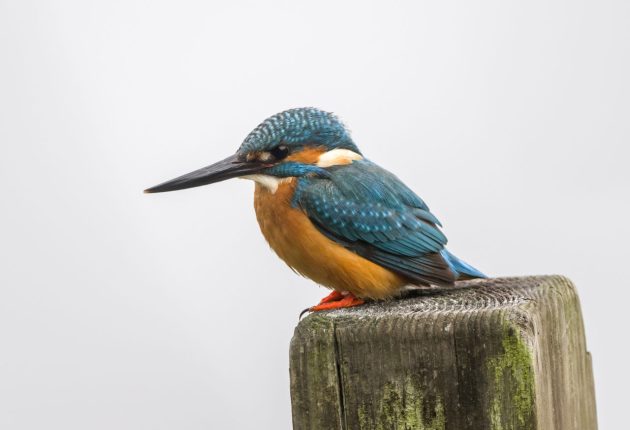
A day’s birding can be deemed a success if one or more things happen to me during the day. Victory if I see all the birds I want to see. This never happens. Glory if I happen to find a snake because it means I have good bushcraft. Or, the ultimate experience, the Nirvana for birders: I see a kingfisher. In my backyard called Europe that means the Common Kingfisher.
The word “common” has been on the sharp end of my wrath so I will limit myself to explaining why I love and adore this bird. Kingfishers are beautiful, the iridescent blue of its back and the bright orange of its chest give the bird a jewel-like appearance, a turquoise gemstone with wings. It also whizzes past when you least expect it. On a derelict shipyard, a sea salt packing plant, or in the middle of a busy city park: “weeet!!” and a blue flash. All you’re left with is the unmistakable impression of the bird and a happy grin on your face (Peter Penning).
Blue-winged Kookaburra
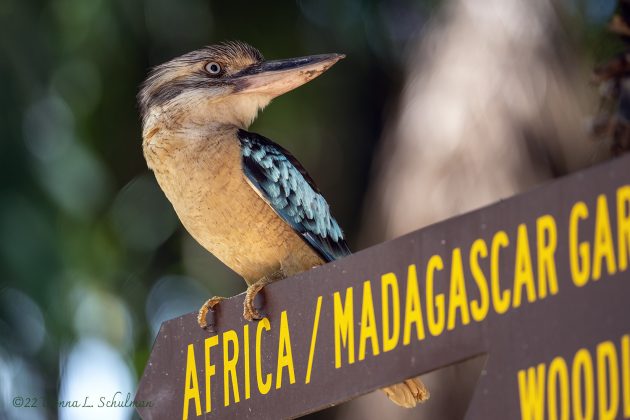
When my friend V told me she saw Laughing Kookaburras every day while growing up in Melbourne, I didn’t quite believe her, but I knew I needed to bird Australia. Kookaburras are mythic birds, figures in a children’s song, snake killers and bringers of good luck, as much representative of Australia as Koalas and Kangaroos, but weirder. What kind of kingfisher looks like a top-heavy super-billed cartoon character and sounds like a cross between a deranged clown and a jackass? Members of genera Dacelo, that’s who.
There are five Kookaburra species, two of which are found mostly in Australia: Laughing Kookaburra and Blue-winged Kookaburra. Laughing Kookaburra is common in eastern mainland Australia; it has also been introduced in southwest Australia, Tasmania, and New Zealand, reportedly to control snakes. Blue-winged Kookaburras are mainly found in north Australia, with a small population in New Guinea. Unlike water-based kingfishers, these terrestrial birds devour creatures large and small, from damselflies, beetles, and spiders to frogs, lizards, snakes, and occasionally nestlings and small mammals.
The first Kookaburra I ever saw was this Blue-Winged Kookaburra in George Brown Darwin Botanical Gardens. It was sitting on top of a large sign as if it owned the place, taking great joy in welcoming us to the Top End. Although I knew it was a kingfisher, its huge head and calm chill, so different from the flighty Belted Kingfishers of North America, charmed me and convinced me that the genus must have mystical origins. (And, indeed, they do make major appearances in Aboriginal stories and their name is derived from the Wiradjuri word for them, Guuguubarra (Donna Schulman).
Laughing Kookaburra
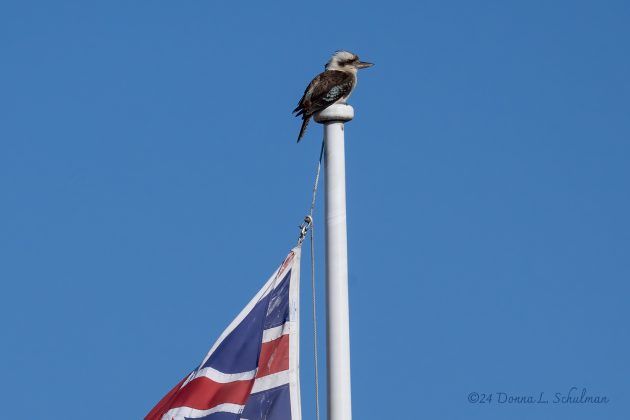
Laughing Kookaburras seemed to be in every park and campground I birded in eastern Australia. Pull up to a nature reserve at dawn, and there’s a Laughing Kookaburra on the entrance sign. Exit Centennial Park in Sydney after dusk, and there’s a Laughing Kookaburra on a branch over the gate. This photo was taken at a small cemetery outside Sydney. Very appropriate, I thought (the Australian flag, not the cemetery part).
The vocalization of the Laughing Kookaburra—it’s laugh–may sound ridiculous or eerie, depending on place, time, and mood. (Blue-winged Kookaburras have a similar vocalization, but deeper.) The call was reportedly used in early Tarzan movies to make viewers feel like they were in an exotic place. If you’ve never heard a Kookaburra call, I highly recommend you check out the recordings on Xeno Canto. Ornithologically, we know this is a territorial vocalization (also used with variations for mating and family contact), but there is folklore attached. One article says that when you hear a Kookaburra ‘laugh’ in the middle of the day (which is unusual) it means it will rain. Or that there is a snake about. Or both! Mostly the bird is said to be the bearer of good luck or new beginnings, since it is heard at dawn. This might say something about the Australian spirit because Kookaburras call at dawn and at dusk, and believe me, you really don’t want to hear a Kookaburra ‘laugh’ at night when you’re walking alone down a dark, deserted street (Donna Schulman).
Belted Kingfisher
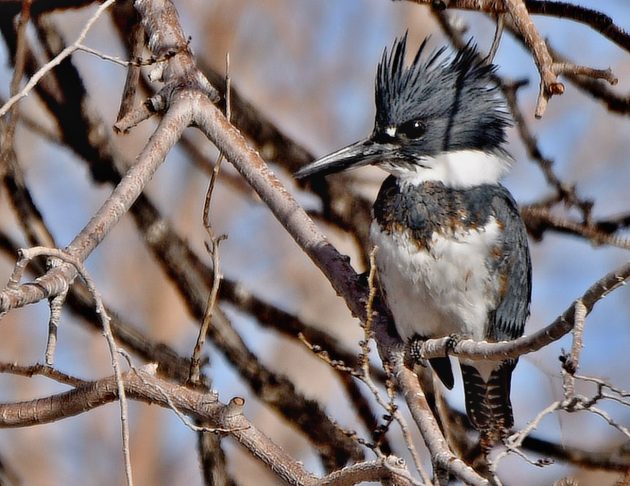
The Belted Kingfisher is one of the few birds I’ve been able to name since childhood. An iconic part of my Maine summers, they chatter wildly while flying across lakes, ponds, and rivers in pursuit of their next fishy meal. Belted Kingfishers can be spotted across North America, ranging north into Canada and Alaska in the summer and moving as far as South America in the coldest months. While their populations are estimated at around 1.8 million, they seem to be on the decline, and are according to the Cornell Lab of Ornithology “sensitive to disturbance…and may abandon territories if people begin frequenting the area” (Erika Zambello).
Amazon Kingfisher
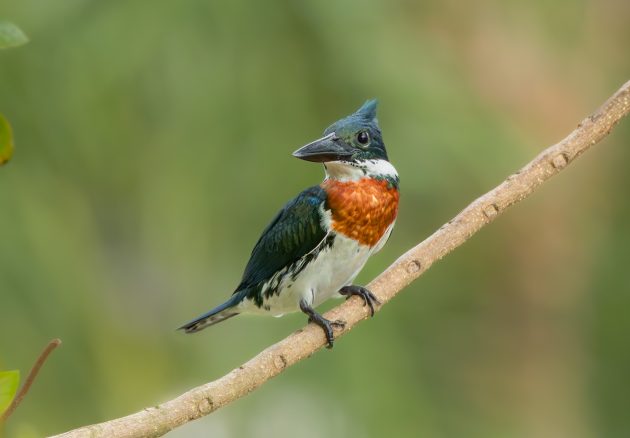
Panama is home to six species of kingfishers, each a little jewel of color and precision, built for life along the waterways. Of these six, I have managed to spot three so far: the Ringed, the Green, and the Amazon Kingfisher. While all are fascinating in their own way, it’s the Amazon Kingfisher that has left the deepest impression on me, and not just because it seems to enjoy taunting me with its elusiveness.
About a year ago, one of these vibrant birds decided to move into my neighborhood. It chose a man-made freshwater lake within our gated community as its domain, which I imagine must have looked like prime real estate for a kingfisher, with plenty of fish and few competitors. At first, this new resident was skittish to the extreme. It had a wide “circle of fear,” darting off at the mere hint of a human figure in the distance. With its keen eyesight, it easily outmaneuvered my attempts to get even a blurry photo. It was, quite literally, keeping me on my toes.
For months, I tried to outwit this bird. Every walk around the lake was an exercise in patience and stealth. Finally, after three months, I captured a half-decent photo. (Emphasis on “half.”) But something magical started happening as time went on. The Amazon Kingfisher began to settle in, staking its claim on a particular perch that it used as both a lookout and a fishing launchpad. It grew more accustomed to the humans strolling by, even allowing me to approach cautiously for a few photos.
What began as a frustrating game of hide-and-seek turned into something almost… mutual. There was trust, at least I like to think so. It stopped fleeing at my approach, content to hold its perch while fixing me with its sharp, calculating gaze. I would watch as it skimmed the lake’s surface or dove with incredible precision to snag its next meal.
Now, a year and a half into this relationship (if one can call it that), seeing the Amazon Kingfisher has become something I look forward to. Every time I spot it, whether on its perch or zipping over the water, I feel a sense of connection that goes beyond mere birdwatching.
But as life goes on, change is on the horizon. Soon, I’ll be moving to the city full-time, leaving behind this quiet oasis and its feathered guardian. While I look forward to the excitement of city life and its urban birding opportunities with its many parks, I can’t help but feel a twinge of sadness at the thought of saying goodbye to this bird. Over time, it became more than just a photo subject, it became a symbol of patience, persistence, and the quiet joys of nature.
When I leave, I’ll carry with me not just my photos of this elegant kingfisher but also cherished memories of our encounters. In a way, it feels like leaving behind a friend, one who speaks in flashes of green and orange, in ripples and dives (Fitzroy Rampersand).
Ringed Kingfisher
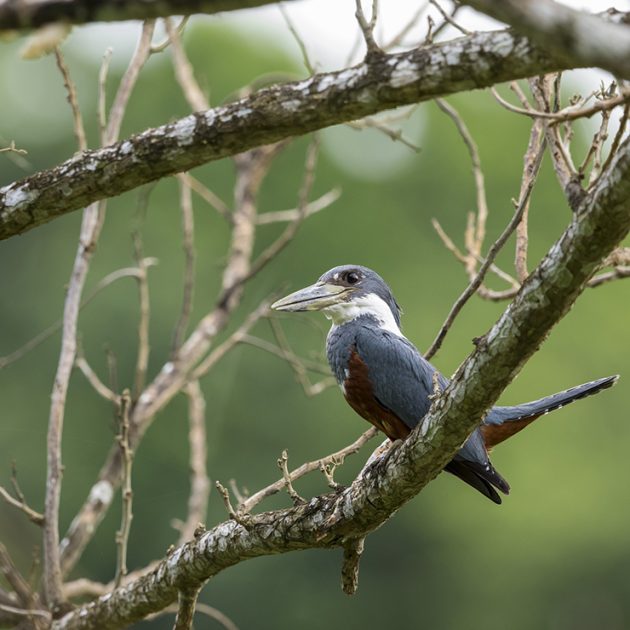
The observation of Ringed Kingfishers as described by the eminent ornithologist Alexander F. Skutch was a “yogic exercise in the contemplation of nothingness” – a far cry from the present insta-exercise of noting field marks or clocking a harsh, rattling call to then announce with confidence: Ringed Kingfisher incoming!
I remember in my very early days birding encountering a Ringed Kingfisher as it accelerated along a slingshot-driven trajectory through a hole in the foliage above a river, exploding into the empty space above an inland pond. I was completely smitten by the chestnut underparts and pure white collar. For such a large bird, it was very skittish – and it took me some time before I was able to get a decent enough view of the slate blue plumage that covered the rest of the bird I hadn’t yet seen. Despite its massive size, it still fits the bill of a kingfisher, with an erect, proud crest and the always-wet look of a scene kid from the 90’s (Faraaz Abdool).
Giant Kingfisher
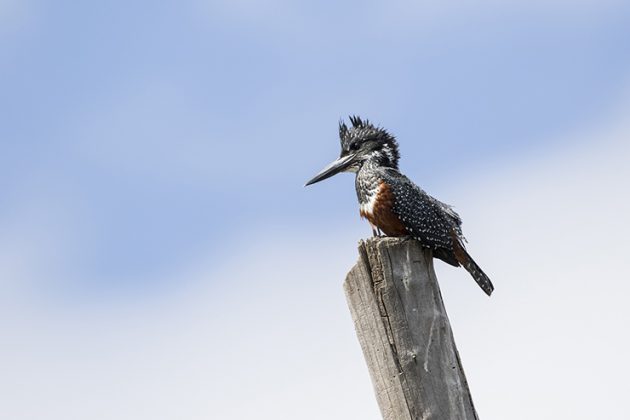
The greatest of great kingfishers, the Giant Kingfisher is fully deserving of its superlative-ridden name. Completely dwarfing almost every other kingfisher on the planet, this massive beast is immediately distinctive in its sub-Saharan home. Apart from its size, the Giant Kingfisher’s distinctive coloration helps to cement it as an “unmistakable” bird. Or, as the field guides love to phrase it: “unlikely to be confused”, as the list of large, crested, and mostly black kingfishers is unsurprisingly short.
Although many African kingfishers are known to feed on terrestrial creatures, the Giant Kingfisher retains its preference for fish, supplementing its piscivorous ways with crabs and the occasional frog or toad. Young kingfishers are fed with fish that are often up to 18cm long. Interestingly, the Giant Kingfisher is able to hone in on its target from a lofty perch that can be several meters above the water’s surface. Humbling, especially seeing that if I lean too far back I won’t be able to see some details on my laptop screen (Faraaz Abdool).
Woodland Kingfisher
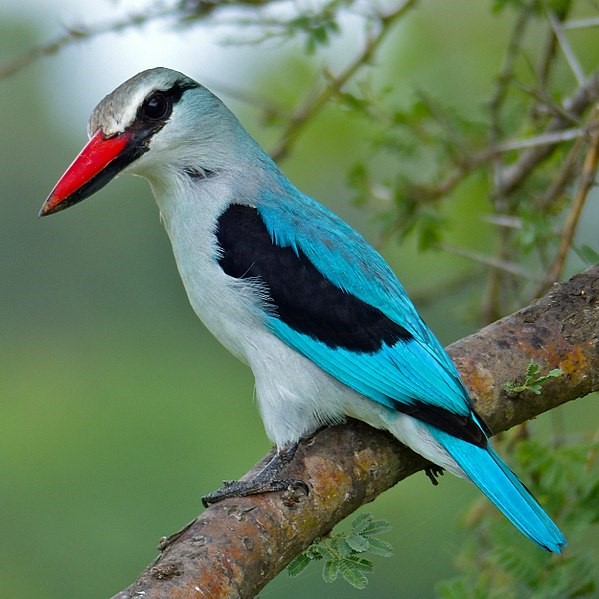
The Woodland Kingfisher, as indicated by its name, is a key representative of the avifauna of sub-Saharan African woodlands. When birding in South Africa in spring, I always loved hearing its distinctive trilling call announcing the return of this intra-African migrant. The birds spread their wings when calling, showing off their amazing electric-blue back and wings. This was a moment I always hoped to capture on camera, but unfortunately did not manage yet (Luca Feuerriegel, photo by Bernard Dupont).
Banded Kingfisher
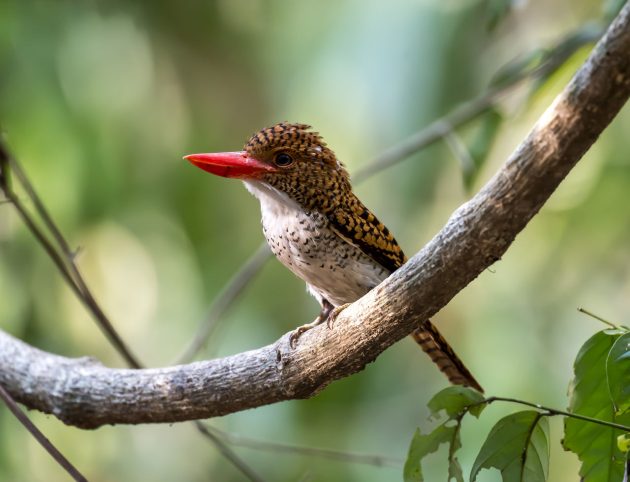
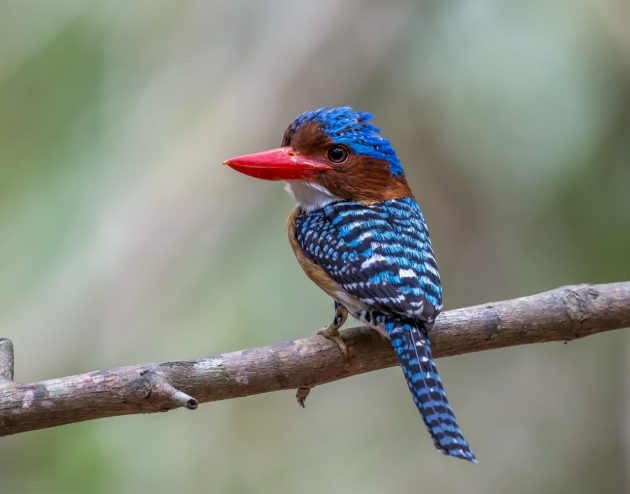
The male Banded Kingfisher was the absolute highlight of a trip to Southern Vietnam, even though this location also offered several beautiful pittas. I guess partly that was because even though I briefly saw the species on Borneo, I entirely missed getting a photo. What adds to the attraction is that apart from being absolutely beautiful, it also has this weird habit of constantly pumping its crest. And as the male and female have very distinct colors, I have a good justification for showing two photos – the male is the blue bird (Kai Pflug).
Black-capped Kingfisher
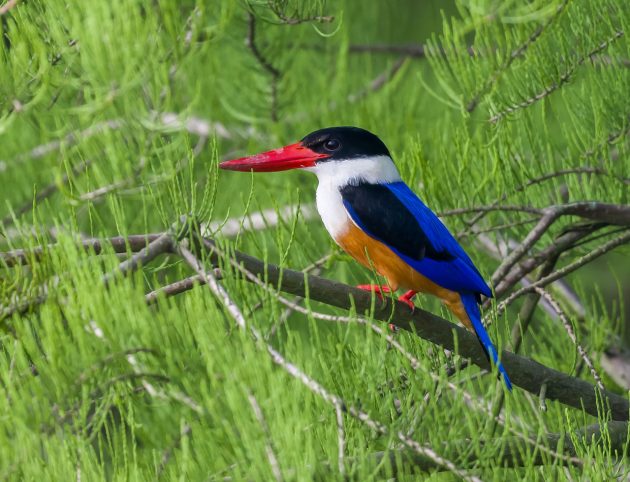
There is one kingfisher species that can easily be seen in Shanghai – the Common Kingfisher. There is one that takes a bit more effort and luck – the Pied Kingfisher. Both have already been described above. That leaves one that is rare and hard to see (and also listed as Vulnerable) – the Black-capped Kingfisher. And it is even harder to get a decent photo, as the bird takes a dim view on being approached by humans. I do too, sometimes, so I understand (Kai Pflug).
Malachite Kingfisher
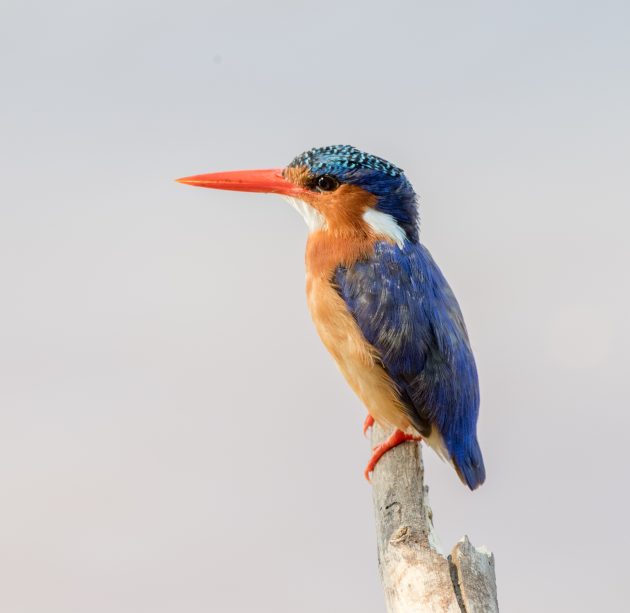
It was one of the Botswana Bird Club camping weekends, this time by the banks of the Limpopo River. There wasn’t much water in it, a puddle here and a pond there, otherwise the bottom was mostly dry – so much so that we walked across it, to check birds at the South African bank (should I add, I did it without a passport or a visa). We were walking through Marico bushveld (a type of savanna habitat) but, using crutches, I was slowly falling behind, until I spotted a large tree trunk lying by the bank and waiting for me to rest on it. By the opposite bank, underneath the protruding acacia roots, there was a puddle, and a Striated Heron looking straight down – I believe it was a lifer to me. But the next bird definitively was a lifer! A few moments later a gorgeous Malachite Kingfisher appeared, with its bright red beak, even more handsome than my Common Kingfisher back home. And I sat there enjoying my first Malachite King. A quarter of a century older, I still remember that youthful scene. What have I done with that quarter? Frightened of this thing that I’ve become, I bless the rains down in Africa … (Dragan Simic).





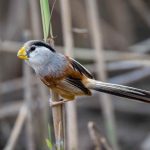

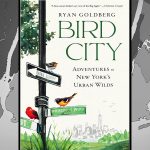
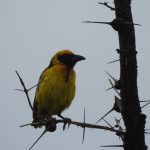

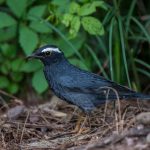

Rarely, I’ve spotted Common Kingfishers with that off-white belly patch like the one in the cover photo – can someone comment on that oddity?
The description of the common kingfisher is amazing, capturing vividly the appearance of the creature and its naughty personality. 🙂 Thans for the collection.
Dragan, could that be wear and tear from entering and leaving the nest hole?
Possibly, if the dates are all from the breeding season… and I’d have to list out all my observations on eBird and open each one to read the comment. A lot of work.
Great post, it really shows off the talents of our writers.
Dragan, that’s the price of knowledge 😉